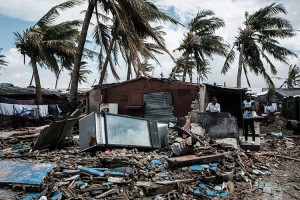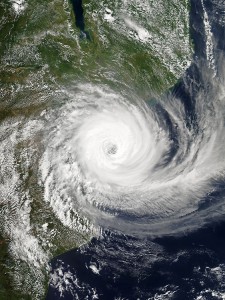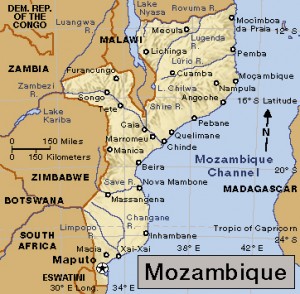Recovering from Cyclone Idai
Friday, April 26th, 2019April 26, 2019
Last month, in March, Tropical Cyclone Idai struck the southeastern coast of Africa. One of the strongest storms ever recorded in the Southern Hemisphere, Idai caused catastrophic landslides and flooding that killed more than 1,000 people in Mozambique and in neighboring Malawi and Zimbabwe. The storm left more than 300,000 people homeless and led to deadly outbreaks of cholera and increased cases of malaria. More than a month later, thousands of people remain missing in affected areas, and government and international aid agencies continue to struggle to provide badly needed food, water, and medical supplies.

On March 23, 2019, residents of Beira, a coastal city in central Mozambique, survey the damage done by Cyclone Idai. Credit: © Yasuyoshi Chiba, AFP/Getty Images
Cyclone Idai formed as a tropical depression over the warm waters of the southwestern Indian Ocean in early March. The storm intensified into a cyclone as it struck central Mozambique on March 4. Torrential rains and deadly winds whipped coastal areas for days as Idai spun along the Mozambique Channel between the African mainland and the island of Madagascar. Idai varied in strength, until reaching peak intensity with winds of 150 miles (240 kilometers) per hour on March 14. After 17 days of damage and deluge, the storm finally weakened and dissipated on March 21.
The broad and determined storm reached inland to Malawi and Zimbabwe and pelted coastal areas of Madagascar. The storm extensively damaged or destroyed vital infrastructure, including communication networks, hospitals, roads, sanitation facilities, and schools. Wide swaths of farmland were ruined, portions of forests were flattened by high winds, and flooding created a temporary inland sea in Mozambique that measured some 80 miles (130 kilometers) long and 15 miles (24 kilometers) wide. Mozambique President Filipe Nyusi called Cyclone Idai a “humanitarian disaster of great proportion.”
Mozambique’s typically able Instituto Nacional de Gestão de Calamidades (National Disasters Management Institute) was overwhelmed by the scale of Idai’s destruction, and an urgent note verbale (formal diplomatic notice) went out requesting international help. The Red Cross and Red Crescent, Doctors Without Borders, and several United Nations organizations came to the rescue, as did the European Union and the governments of Canada, France, Portugal, South Africa, and the United Kingdom.
Cyclone Idai was the seventh tropical cyclone of the Indian Ocean season, more than twice the average for this time of year. Globally, high-intensity storms have been occurring more frequently in recent years, a trend directly related to climate change. Global warming increases sea temperatures, creating more moisture and instability in the atmosphere—factors crucial to the birth of dangerous cyclones and hurricanes. Tropical cyclones need high humidity and surface water temperatures of 79 °F (26 °C ) or higher to form. Melting glaciers and ice have increased global sea levels, resulting in more frequent and intense flooding in coastal areas around the world.





